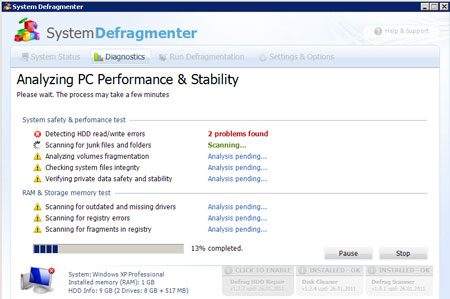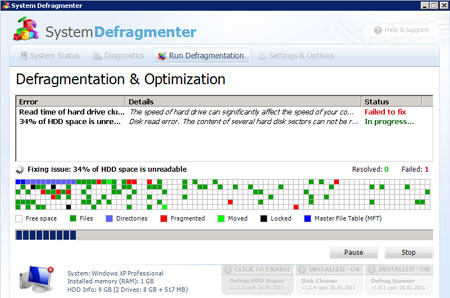TROJ_FAKEAL.GG
Trojan:Win32/Tibs (Microsoft); Trojan.FakeAV!gen36 (Symantec); FakeAlert-AntiVirusPro.gen.f (McAfee); Trojan-Downloader.Win32.FraudLoad.xxoq (Kaspersky); W32/FakeAlert.PCK!tr (Fortinet)
Windows 2000, Windows XP, Windows Server 2003


Threat Type: Trojan
Destructiveness: No
Encrypted: Yes
In the wild: Yes
OVERVIEW
It displays fake alerts that warn users hard drive errors. It also displays fake system diagnostics results of the affected system. It then asks for users to purchase it once scanning is completed. If users decide to purchase the rogue product, users are directed to a website asking for sensitive information, such as credit card numbers.
This Trojan may be unknowingly downloaded by a user while visiting malicious websites.
It adds registry entries to enable its automatic execution at every system startup.
It connects to a website to send and receive information.
It modifies the Internet Explorer Zone Settings.
TECHNICAL DETAILS
Arrival Details
This Trojan may be unknowingly downloaded by a user while visiting malicious websites.
Installation
This Trojan drops the following copies of itself into the affected system:
- %User Temp%\tmp3.tmp
- %User Temp%\upd32.exe
(Note: %User Temp% is the current user's Temp folder, which is usually C:\Documents and Settings\{user name}\Local Settings\Temp on Windows 2000, XP, and Server 2003.)
It drops the following files:
- %User Temp%\{random number}.exe - also detected as TROJ_FAKEAL.GG
- %User Temp%\upd32.dll - also detected as TROJ_FAKEAL.GG
- {malware path}\{random number}.exe - also detected as TROJ_FAKEAL.GG
- %User Temp%\{random number}
- %Start Menu%\Programs\System Defragmenter\System Defragmenter.lnk
- %Desktop%\System Defragmenter.lnk
(Note: %User Temp% is the current user's Temp folder, which is usually C:\Documents and Settings\{user name}\Local Settings\Temp on Windows 2000, XP, and Server 2003.. %Start Menu% is the current user's Start Menu folder, which is usually C:\Windows\Profiles\{user name}\Start Menu on Windows 98 and ME, C:\WINNT\Profiles\{user name}\Start Menu on Windows NT and C:\Windows\Start Menu or C:\Documents and Settings\{User name}\Start Menu on Windows 2000, XP, and Server 2003.. %Desktop% is the current user's desktop, which is usually C:\Windows\Profiles\{user name}\Desktop on Windows 98 and ME, C:\WINNT\Profiles\{user name}\Desktop on Windows NT, and C:\Documents and Settings\{User Name}\Desktop on Windows 2000, XP, and Server 2003.)
Autostart Technique
This Trojan adds the following registry entries to enable its automatic execution at every system startup:
HKEY_CURRENT_USER\Software\Microsoft\
Windows\CurrentVersion\Run
upd32.exe = %User Temp%\upd32.exe
HKEY_CURRENT_USER\Software\Microsoft\
Windows\CurrentVersion\Run
{random number} = %User Temp%\{random number}.exe
Other System Modifications
This Trojan adds the following registry entries:
HKEY_CURRENT_USER\Software\Microsoft\
Windows\CurrentVersion\Internet Settings
WarnOnZoneCrossing = 0
HKEY_CURRENT_USER\Software\Microsoft\
Internet Explorer\Main
Use FormSuggest = Yes
HKEY_CURRENT_USER\Software\Microsoft
BootData = %User Temp%\{random number}.exe
Backdoor Routine
This Trojan connects to the following websites to send and receive information:
- http://{BLOCKED}ullvic.com/readdatagateway.php
Web Browser Home Page and Search Page Modification
This Trojan modifies the Internet Explorer Zone Settings.
Other Details
This Trojan does the following:
- Displays fake alerts, such as the following:





- Displays fake warning on hard drive errors. It also displays fake system diagnostics results of the affected system. It then asks for users to purchase it once scanning is completed. If users decide to purchase the rogue product, users are directed to the following website asking for sensitive information, such as credit card numbers:
- http://{BLOCKED}e.defragmentetorstore.com/secure/payments
SOLUTION
Step 1
For Windows ME and XP users, before doing any scans, please make sure you disable System Restore to allow full scanning of your computer.
Step 2
Scan your computer with your Trend Micro product and note files detected as TROJ_FAKEAL.GG
Step 3
Restart in Safe Mode
Step 4
Delete this registry value
Important: Editing the Windows Registry incorrectly can lead to irreversible system malfunction. Please do this step only if you know how or you can ask assistance from your system administrator. Else, check this Microsoft article first before modifying your computer"s registry.
- In HKEY_CURRENT_USER\Software\Microsoft\Windows\CurrentVersion\Run
- upd32.exe = %User Temp%\upd32.exe
- In HKEY_CURRENT_USER\Software\Microsoft\Windows\CurrentVersion\Run
- {random number} = %User Temp%\{random number}.exe
- In HKEY_CURRENT_USER\Software\Microsoft\Windows\CurrentVersion\Internet Settings
- WarnOnZoneCrossing = 0
- In HKEY_CURRENT_USER\Software\Microsoft\Internet Explorer\Main
- Use FormSuggest = Yes
- In HKEY_CURRENT_USER\Software\Microsoft
- BootData = %User Temp%\{random number}.exe
Step 5
Search and delete this file
- %User Temp%\{random number}
- %Start Menu%\Programs\System Defragmenter\System Defragmenter.lnk
- %Desktop%\System Defragmenter.lnk
Step 6
Reset Internet security settings
Step 7
Search and delete the file detected as TROJ_FAKEAL.GG
Step 8
Restart in normal mode and scan your computer with your Trend Micro product for files detected as TROJ_FAKEAL.GG If the detected files have already been cleaned, deleted, or quarantined by your Trend Micro product, no further step is required. You may opt to simply delete the quarantined files. Please check this Knowledge Base page for more information.
Did this description help? Tell us how we did.

